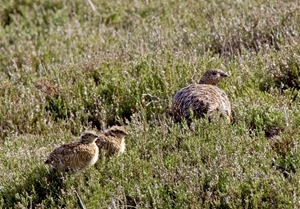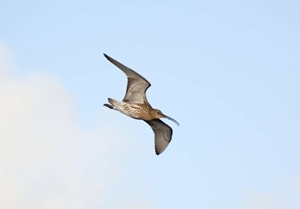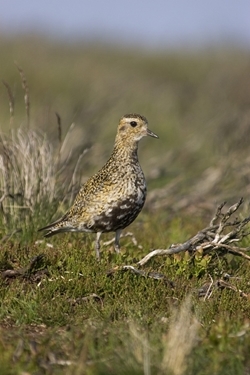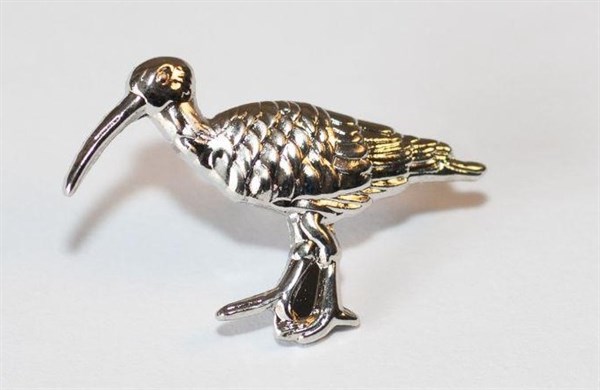Summary
- Many wader species are in decline, with curlew and lapwing of particular conservation concern in the UK. Several of these waders breed on upland moorland or moorland fringes and may be affected by grouse moor management.
- This study looked at how curlew, lapwing, golden plover and snipe numbers responded to the restoration of grouse moor management on Langholm moor in Scotland, where management had previously stopped for eight years.
- When not managed as grouse moor, curlew, lapwing and golden plover numbers had been falling, while snipe had been increasing.
- When grouse moor management was restarted, curlew numbers rose by 10% per year, golden plover by 16% per year and snipe by 21% per year on average. Lapwing numbers did not change.
- Grouse moor management allowed numbers of curlew and golden plover to recover despite ongoing national and regional declines.
Background
 Management for red grouse includes both predator control and heather management. Reducing the number of generalist predators protects the grouse and their chicks from high levels of predation. Burning and cutting aims to keep the heather vegetation in a healthy condition, as well as providing a mosaic of heather at different heights, which is good for grouse. Both aspects of grouse moor management can also benefit other species that live and breed on the moorland.
Management for red grouse includes both predator control and heather management. Reducing the number of generalist predators protects the grouse and their chicks from high levels of predation. Burning and cutting aims to keep the heather vegetation in a healthy condition, as well as providing a mosaic of heather at different heights, which is good for grouse. Both aspects of grouse moor management can also benefit other species that live and breed on the moorland.
What they did
This study examined how changes in grouse moor management affected breeding numbers of four wader species (curlew, golden plover, lapwing and snipe) on Langholm moor. To understand the study, we need to understand the management changes.
| 1992-1999 |
|
Langholm moor was managed for red grouse up until 1999, when grouse moor management stopped. Sheep were also grazed on the moor in this period.
|
| 2000-2007 |
|
No grouse moor management, but sheep grazing continued.
|
| 2008-2016 |
|
Grouse moor management restarted as part of the Langholm Moor Demonstration Project. Sheep grazing ceased on much of the degraded heather in 2011.
|
| 2017-2018 |
|
No grouse moor management. Sheep grazing remained reduced.
|
Grouse moor management included the legal control of foxes, crows, stoats and weasels across the whole study area. Heather management, i.e. burning or cutting of small heather patches, focused on the central part of the study area with heather vegetation. To help with heather recovery, sheep grazing was reduced on most of the heather moorland from 2011 onwards.
Each year, the number of breeding curlew, golden plover, lapwing and snipe were surveyed on Langholm moor between mid-April and mid-June.
The scientists looked at changes in the number of breeding waders throughout a ten-year period after grouse moor management was reinstated (2008-2017). Although management had stopped again by 2017, this year was included as any wader chicks that fledged in 2016, when the moor was still managed, could return as breeding adults in 2017. The scientists then compared this with regional and national trends of these species during the same period, as well as with the other management periods at Langholm.
What they found
 After grouse moor management was restored, curlew numbers increased by on average 10% per year, golden plover by 16% per year, and snipe by 21% per year. This contrasted with the trends seen nationally and in the wider Langholm area, where all these species were declining. Lapwing numbers remained stable on Langholm and in the wider area, but declined across Scotland.
After grouse moor management was restored, curlew numbers increased by on average 10% per year, golden plover by 16% per year, and snipe by 21% per year. This contrasted with the trends seen nationally and in the wider Langholm area, where all these species were declining. Lapwing numbers remained stable on Langholm and in the wider area, but declined across Scotland.
The observed changes in wader numbers were the same on both the central heather-dominated part of the study area, where both predator control and heather management were carried out, and the surrounding grass-dominated area, where only predator control was carried out. Golden plover was the only species with a strong preference for managed heather, whereas breeding densities of curlew, lapwing and snipe were higher in grass-dominated areas.
Although grouse moor management stopped again in spring 2016, the beneficial effect on waders lasted into 2017, probably because chicks that fledged in the previous year returned to the area to breed. By 2017, however, predator numbers had risen again and numbers of all waders fell in 2018.
Comparing the different management periods showed that breeding densities of curlew, golden plover and lapwing were highest during the first managed period (1992-1999), but fell when grouse moor management ceased in 1999. Curlew and golden plover, but not lapwing, then showed a partial recovery when management was restored in 2008. Snipe numbers were lowest in the first managed period, but rose during the period of no management, and continued rising when grouse moor management was reinstated.
What does this mean?
 This study showed that restoring grouse moor management on Langholm moor increased breeding numbers of curlew and golden plover, which were previously in decline, as well as snipe. Lapwing numbers did not change. These trends are counter to the regional and national trends, which show declines for all species.
This study showed that restoring grouse moor management on Langholm moor increased breeding numbers of curlew and golden plover, which were previously in decline, as well as snipe. Lapwing numbers did not change. These trends are counter to the regional and national trends, which show declines for all species.
Management for grouse included both predator control and heather management, which were introduced together, making it difficult to separate their relative effects. However, our results showed that changes in wader numbers were the same on both the managed heather moorland and the surrounding grassland. This indicated that the observed increases were largely associated with reduced predator abundance, which occurred across the whole study area. As many waders prefer short vegetation, heather burning or cutting may provide additional benefits. However, at Langholm, this may have been counteracted by reductions in sheep grazing, which increased vegetation height and density.
Predator control on the study area reduced fox and crow abundance by more than half. Predation is known to be a limiting factor for wader populations, and previous GWCT research showed that predator control alone can allow local populations of breeding waders to grow. This agrees with other studies comparing moors that are managed for grouse with those that aren’t, which generally find between two and five times higher breeding densities of curlew, golden plover and lapwing on grouse moors.
This study highlights how management for red grouse can contribute to the conservation of other ground-nesting birds. Now that grouse moor management has stopped again on Langholm moor, wader numbers are expected to decline once again, as already indicated by lower breeding numbers in 2018.
This study was part of the Langholm Moor Demonstration Project, a long-running collaboration between the GWCT, SNH, Buccleuch Estates, the RSPB and Natural England, which aimed to resolve conflict between driven grouse shooting and raptor conservation.
Read the original abstract
Ludwig SC, Roos S, Baines D (2019) Responses of breeding waders to restoration of grouse management on a moor in South-West Scotland. Journal of Ornithology 160: 789–797.
About the LMDP
This study was part of the Langholm Moor Demonstration Project, a long-running collaboration between the GWCT, SNH, Buccleuch Estates, the RSPB and Natural England, which aimed to resolve the conflict between driven grouse shooting and raptor conservation. Further papers from the Langholm Moor Demonstration Project can be found on the LMDP website.
References
- Roos, S., Smart, J., Gibbons, D.W. & Wilson, J.D. (2018). A review of predation as a limiting factor for bird populations in mesopredator-rich landscapes: A case study of the UK. Biological Reviews, 93:1915–1937.
- Fletcher, K., Aebischer, N.J., Baines, D., Foster, R. & Hoodless, A.N. (2010). Changes in breeding success and abundance of ground-nesting moorland birds in relation to the experimental deployment of legal predator control. Journal of Applied Ecology, 47:263–272.
- Tharme, A.P., Green, R.E., Baines, D., Bainbridge, I.P. & O’Brien, M. (2001). The effect of management for red grouse shooting on the population density of breeding birds on heather-dominated moorland. Journal of Applied Ecology, 38:439–457.
- Newey, S., Mustin, K., Bryce, R., Fielding, D. & Redpath, S. (2016). Impact of Management on Avian Communities in the Scottish Highlands. PloS one, 11:e0155473.
- Thompson, D.B.A., Gillings, S.D., Galbraith, C.A., Redpath, S.M. & Drewitt, J. (1997). The contribution of game management to biodiversity: a review of the importance of grouse moors for upland birds. In: Biodiversity in Scotland: Status, Trends and Initiatives: 198–212. (eds. Fleming, L.V., Newton, A.C., Vickery, J.A. & Usher, M.B.) TSO. Edinburgh.

Get your Curlew Supporters Badge for £9.99
You can help us get practical curlew conservation advice to those on the ground by buying one of our curlew pin badges. £5 from the sale of each badge goes to our Action For Curlew project, which is helping to provide advice to farmers, landowners and gamekeepers on the action they can take to reverse the alarming decline in curlew numbers. Badge measures approx 3cm.
View Badge >
or
Buy Now - £9.99 >
100% Secure. All Credit & Debit cards, PayPal, Apple Pay and Google Pay accepted.
